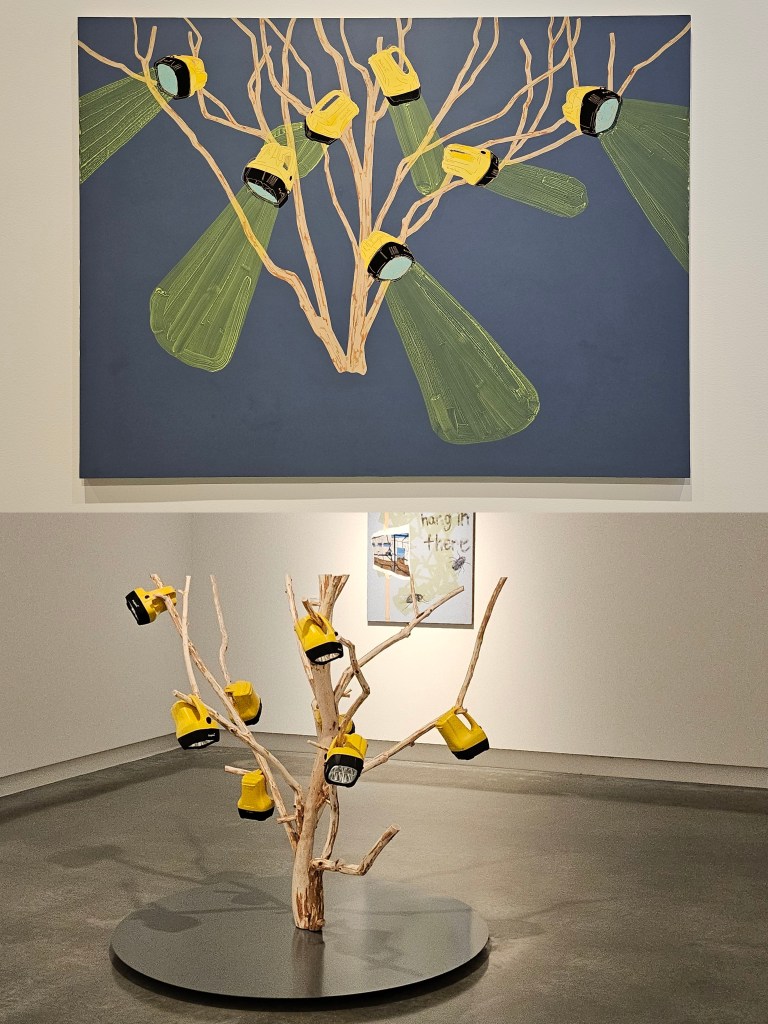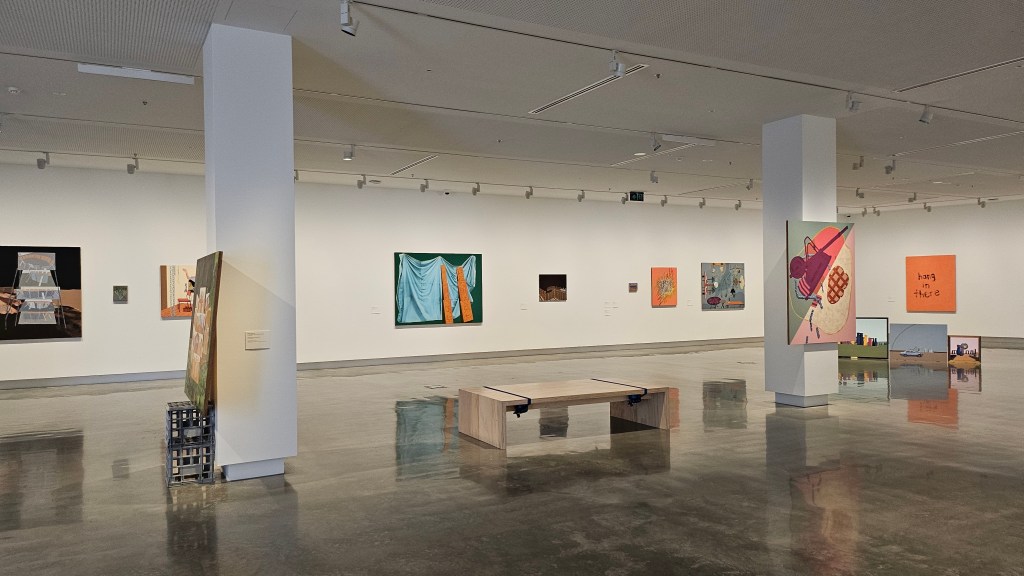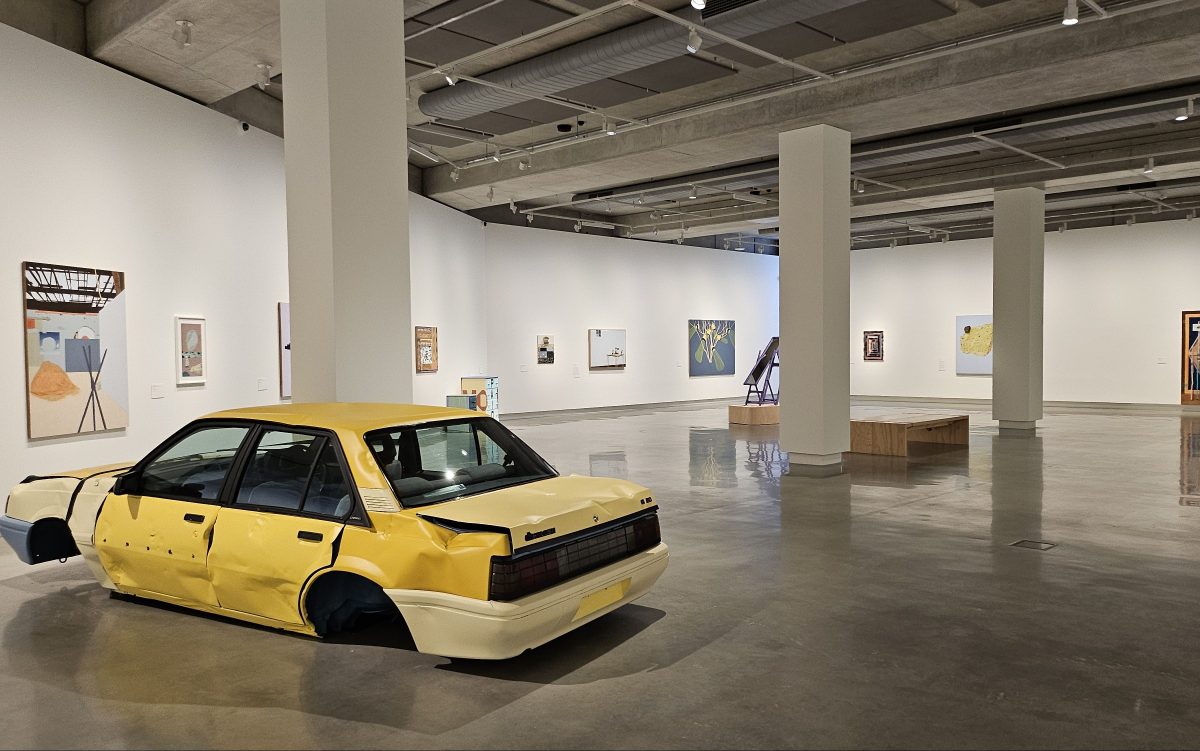While dreamy pastels and construction material may not be a natural pairing, they prove to be synergetic partners in Nadine Christensen’s practice. Her first major survey, Around, is an expansive exhibition that matches her equally prolific career.
Paintings dominate in the show at Buxton Contemporary, but their subjects, compositions and materials are varied, creating a well-rounded experience for prolonged viewing. One prime example is Where Looking Feels Like Thinking (Expect Delays) (2020-23), one of the very first works encountered in the exhibition. The background looks as if the wrecked bus stop precariously held together by red and white safety tape has smashed through the pictorial plane. It sticks awkwardly halfway between its native setting and the canvas, embodying almost a cartoonish characteristic.
Other works also play on this trope, including Fantastic Plan (1999), Flat Painting (2019-23), See-through (2014) and Stained Glass and Hideouts (2009), all of which straddle the duality of the life setting and the painterly setting with humour and intrigue.
The incorporation of multimedia material onto the characteristically two-dimensional compositions can be seen in works such as Untitled (Vanity) (2016) with a rocky porous surface, and a literal rock floating on the corner of a painted rock in Stone (2016). Around 2017, text began to feature in Christensen’s compositions, phrases that capture domesticity, womanhood and work rights, with a sense of both hope and despair.

This plethora approach to painting signals active and ongoing experimentation on the part of the artist, something that spurs anticipation in Christensen’s work and throughout the exhibition. If painting exists on one end of the spectrum and sculpture on the other, the juxtaposition of Up All Night (2023) and She Smoked (2023) speaks to Christensen’s investigation of each medium independently. Perhaps intentionally displayed in separate gallery spaces, the two works depict the same form of Dolphin torches hanging on branches, one in acrylic on board and the other, an interactive sculptural installation.
At times, Around resembles a pre-school classroom in its colour, arrangement and atmosphere. Craft influences are most prominent in Back Chat (2009), an interactive DIY instrument producing a loud clang that disrupts the quiet hush of the institution in which it is housed. It’s silly and, quite frankly, unafraid to break the rules. Viewers are sometimes also the target of these “tricks” in the participatory works. Signals and Decoys (2023) asks visitors to tug on a pulley without seeing or knowing its effect, as the pulley is situated downstairs, but the wheel it activates is hidden from view on the level above. While visitors may be rather dumbfounded after tugging the pulley, it is followed by joy and a chuckle when seeing the flag windmill in motion – only to leave the next curious passerby baffled, until they, too, make the ascension to the next level.
Sculptural installations actively challenge visitors’ spatial awareness, forcing them to make conscious decisions around how they navigate and perceive the exhibition – a delight rather than a cumbersome chore. This can be seen in the example of Do We Go Around Houses or Do Houses Go Around Us (2021-23), a wheel-less found car placed slightly too close to the sliding door leading into the space, rather than in the centre where one may expect.
Everything Is Interesting, (Things That Feel Like People) (2023) is the only work with a mirror surface in the exhibition, a material not often employed in Christensen’s works. The polished, reflective surface stands in contrast to the bumpy and tactile purple frame, its form somewhere between a miniature slide and a clothing rack. Here, Christensen purposefully highlights the mirror’s dysfunctionality, placing it on a wooden block and slightly tilted too high to be effective in reflecting our own image. Rather, the piece becomes a symbiotic mirror for the space and works around it.

In Around, Christensen constantly resists works and exhibition design that make it too easy for the viewers. This is presented in a less straightforward, but more tongue-in-cheek manner upstairs, with two wooden exhibition benches bound together using bright blue tie-down straps. Instantly, there is a question of whether these are artworks or exhibition furniture, prompting the internal struggle of whether or not they may be sat on, with the risk of breaking art-viewing etiquette.
Read: Exhibition review: Works of Nature: Marshmallow Laser Feast, ACMI
While showcasing the breadth of engagement and evolving nature of Christensen’s practice, Around is, most of all, an exhibition that is fun to see and be a part of. It invites viewers to be active and, indeed, for them to activate the works, centring us in Christensen’s world, which prioritises expression and curiosity over rules and discipline.
Nadine Christensen: Around is on view until 7 April 2024 at Buxton Contemporary; free entry.





